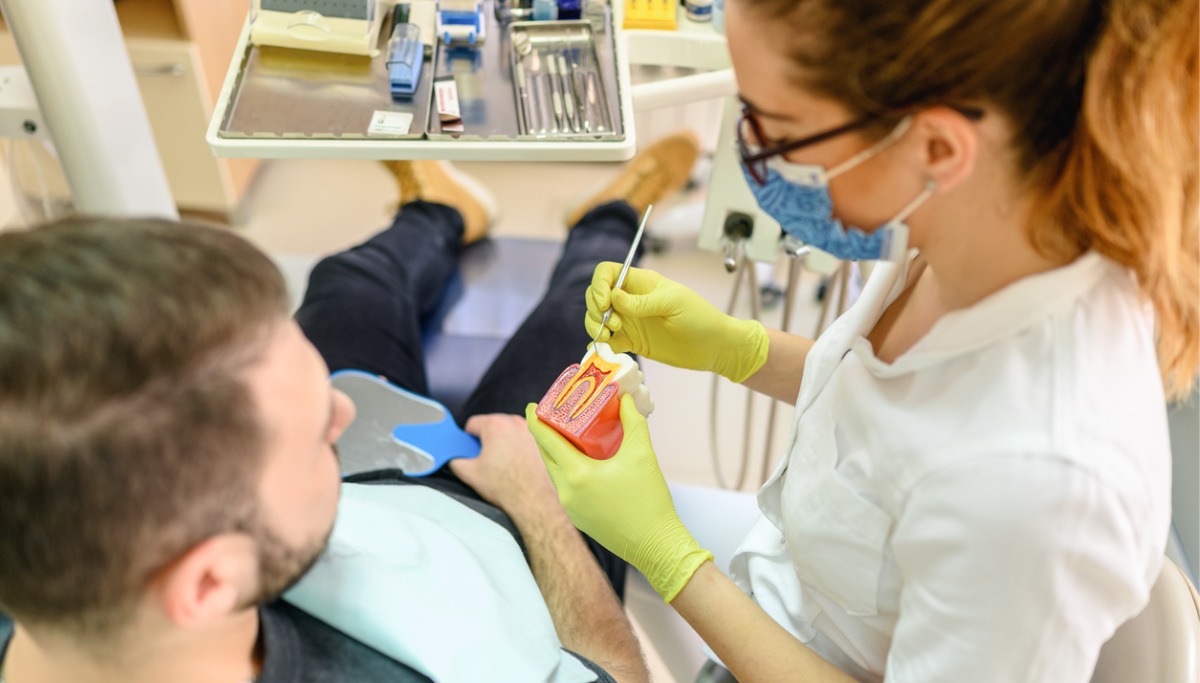What is periodontitis?
What is periodontitis? 1
Periodontal disease refers to any infection of the soft tissue and bone that holds your teeth in place. Periodontitis is a more severe form of periodontal disease that, without proper treatment, can destroy the attachment of the gums to the teeth and the bone that supports your teeth. This can lead to sore, bleeding gums, bad breath, loose teeth, and even result in tooth loss.
What are the common causes of periodontitis? 2
Periodontitis is common but largely preventable. In fact, 47.2% of adults aged 30 years and older have some form of periodontal disease in the U.S.
Periodontitis is a bacterial infection of the gums usually caused by poor oral hygiene. Our mouth is filled with millions of bacteria. Most are harmless, but some can infect and damage the teeth and gums. These bacteria constantly form a sticky, colorless “plaque” on teeth. Failure to remove this plaque on a daily basis and get regular dental checkups can result in an easily controlled problem turning into something that can end in tooth loss. Early gum disease is called gingivitis and is easily reversible. However, if left untreated, gingivitis can progress to periodontitis as the plaque buildup begins to spread below the gum line and attacks the attachment of the gum to the tooth. This leads to progressive loss of attachment and, eventually, bone loss.
Furthermore, certain risk factors, in particular, smoking, are associated with this type of periodontal disease. Additional risk factors include diabetes and other medical conditions, dry mouth, hormonal changes in girls and women, and genetic susceptibility. Learn more about the causes of periodontitis.
What are the signs & symptoms of periodontitis?
Healthy gums are typically firm, pale pink in color, and fit around teeth. Symptoms of periodontitis can be very mild, like gingivitis, particularly early in the process. Signs and symptoms of periodontitis can include:
- Red or swollen gums
- Gums that bleed easily
- Painful chewing
- Bad breath
- Loose teeth
- Receding gums
It’s important to know what symptoms to look for and follow your dentist’s recommended schedule for regular dental checkups. In doing so, you can catch periodontitis early and greatly improve your chances of successful treatment. Learn more about the signs and symptoms of periodontitis.
How do you diagnose and treat periodontitis?
With the help of a dentist, periodontitis is easily diagnosable and treatable. To determine whether you have periodontitis and how severe it is, your dentist may probe pockets between your teeth and gums and check if there is any bone loss on X-rays.
There are both non-surgical and surgical treatments available which include scaling and root planing, antibiotics, and bone grafting. Periodontitis treatment aims to extensively clean the pockets around your teeth to prevent further damage to the surrounding bone. Learn more about how your dentist will diagnose and treat periodontitis.
FAQ on Periodontitis
Here are some answers to frequently asked questions about periodontitis.
Periodontitis can’t be reversed, but you can stop it from advancing further. For that reason, it is critical to notice the signs of gingivitis and catch it in its early stages to prevent it from progressing to periodontitis.
Periodontitis is a severe form of gum disease that can lead to tooth loss or other serious health complications. If left untreated, periodontitis can damage the soft tissue that surrounds your teeth and destroy the bone that supports it.
The pockets around your teeth become breeding grounds for bacteria that cause the infection. Furthermore, the bacteria can enter your bloodstream through the gum tissue and possibly affect other parts of your body.
To prevent progression to severe stages of periodontitis, a prompt diagnosis of the disease at its earliest stages is critical. Slight and moderate chronic periodontitis can be successfully managed by the removal and reduction of plaque and calculus.
Looking for more information? Learn more about gum disease:
Sources:
1 U.S. Department of Health and Human Services. (n.d.). Periodontal (Gum) Disease. National Institute of Dental and Craniofacial Research. https://www.nidcr.nih.gov/health-info/gum-disease/more-info.
2 Mayo Foundation for Medical Education and Research. (2020, February 14). Periodontitis. Mayo Clinic. https://www.mayoclinic.org/diseases-conditions/periodontitis/symptoms-causes/syc-20354473.




